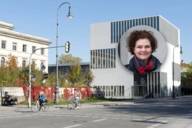
Tour guide Christiane Haack studied art history at Ludwig-Maximilians-Universität in Munich. No wonder, then, that she has been enthusiastically guiding visitors through the Kunstareal (art quarter) and the university district of Maxvorstadt since 2010, for there are more museums and galleries in this district than in any other.
“Maxvorstadt, so it is hard for me to pick a favourite. I think Alte Pinakothek (art gallery) is particularly great – the renovated rooms, the well-chosen composition, the iconic works by Dürer, Rubens and many others. But Neue Pinakothek (art gallery) is also special: King Ludwig I had it built to make the art of his time accessible to a broad public. For visitors at the time, the Neue Pinakothek (art gallery) was just as modern as Museum Brandhorst (art gallery) is for us today.
No less exciting for me is the NS-Dokumentationszentrum (Munich Documentation Centre for the History of National Socialism) especially in connection with my guided tours of the KZ-Gedenkstätte Dachau (Dachau Concentration Camp Memorial Site). A genuine insider tip, I believe is Museum für Abgüsse Klassischer Bildwerke (museum for casts of classical works of art): With free admission, an amazing exhibition space opens up in front of you. In Maxvorstadt, I often feel like being transported back to my student days – even though a lot has changed since then: Today, there is a wider range of art and culture than ever before. Munich has always been a city of art – and that's especially noticeable here.“
No other district in Munich has such a high density of galleries and museums, as well as colleges and universities as Maxvorstadt. There is also a lot of history to be explored in this relatively young district. It was founded in 1825 by King Ludwig I, who at the same time had Königsplatz (square) built on the model of the Acropolis in Athens. And Ludwig-Maximilians-Universität went down in history with Sophie Scholl and the Weisse Rose resistance movement.
Maxvorstadt is also known as Munich's student quarter, which is why there are particularly many bars in the streets around the University. A popular address that set its mark in the fast-paced neighbourhood is Bar Sehnsucht. Café Jasmin, a few streets away, has been serving coffee and cake since 1948. And the Augustiner-Keller in the direction of the main railway station was opened as early as the 19th century and is now one of the most popular beer gardens.
The largest cultural attraction in Maxvorstadt is, of course, the Kunstareal (art quarter), but there are also several other cultural offerings: For example, one of the small traditional cinemas like Studio Isabella, where many original films and Spanish titles are screened. Or the unique Munich children’s theatre, where classics like “Die kleine Hexe” (The Little Witch) has been staged for many decades. And also Amerikahaus (cultural institution) with an exciting programme of exhibitions and panel discussions.
In addition to the city centre and Glockenbachviertel, Maxvorstadt is a popular shopping district: small boutiques line up with selected second-hand stores – some of which also offer vintage traditional dress. Furthermore, the district is home to two Munich success stories: baker Julius Brantner, whose bread has become famous far beyond the city boundaries, and fashion label ‘A Kind Of Guise’. Their clothes are produced exclusively in Germany and have now gained a worldwide reputation.
If you want to explore all the museums in the district, you should take your time. The Kunstareal attracts visitors with 18 museums and 40 galleries, including the three Pinakothek art galleries, Museum Brandenhorst (art gallery), the Lehnbachhaus art gallery and the NS-Dokumentationszentrum (Munich Documentation Centre for the History of National Socialism). The Glyptothek (art gallery), the Staatliche Antikensammlung (state collections of antiquities), as well as Museum für Abgüsse Klassischer Bildwerke (museum for casts of classical works of art) are located at Königsplatz (square).